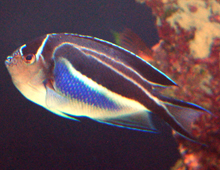Description: The male Bellus lyretail angelfish has a pattern of gold strips bordering a broad pinkish band. The female has a striking pattern of black, white, and purplish-blue. The Latin word “bellus” means “beautiful”. The Greek word “genicanthus” means “cheek spine”. Both genders have a tail that tapers into the body.
Size: They reach a maximum length of seven inches (18 cm).
Behavior: These rather active, yet usually calm fish, form harems of three to seven individuals.
Diet: Bellus lyretail angelfish are omnivores, eating zooplankton and marine vegetation especially algae.
Reproduction: Bellus angelfish are hermaphroditic, meaning they have the ability to change sex from female to male and males can even go back to being female. They are pelagic spawners, the male and female rise up into the water column with the male lining up his vent with the female and then they release sperm and eggs.
Habitat/range: This species is found in reefs in the Western Pacific and Eastern Indian Oceans, often near drop-offs to depths of up to 400 feet (122 m).
Status: Listed as Least Concern on IUCN Red List.



